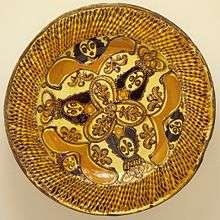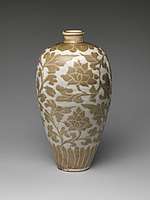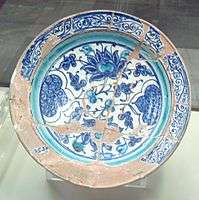Slip (ceramics)
A slip is a liquid mixture or slurry of clay and/or other materials suspended in water. It has many uses in the production of pottery, and other ceramic wares.[1]
.jpg)
In pottery the two most important uses of slip are: firstly, to form the basic shape by slipcasting with moulds; this has been extremely important for several centuries, and secondly, to protect or decorate the pottery, which is discussed below.
Engobe, from the French word for slip, is an American English term for materials similar to a slip, though the definition seems variable. Some American sources say it is synonymous with slip, and use it in preference to "slip",[2] while others draw distinctions,[3] mainly in terms of engobe using materials other than clay. On one definition engobe, as compared to slip, has somewhat lower clay content, higher proportion of flux, and added filler, and in some cases a colorant.[4] It is mostly used in relation to contemporary pottery, but sometimes for slip in historical contexts.
Decoration and protection

Slipware is pottery decorated by slip placed onto a wet or leather-hard clay body surface by dipping, painting or splashing. Some slips will also give a moderate degree of the hardening effect, and decreased permeability, that a ceramic glaze would give. Often only pottery where the slip creates patterns or images will be described as slipware, as opposed to the many types where a plain slip is applied to the whole body, for example most fine wares in Ancient Roman pottery, such as African red slip ware (note: "slip ware" not "slipware"). Decorative slips may be a different colour than the underlying clay body or offer other decorative qualities such as a shiny surface.
Selectively applying layers of colored slips can create the effect of a painted ceramic, such as in the black-figure or red-figure pottery styles of Ancient Greek pottery. Slip decoration is an ancient technique in Chinese pottery also, used to cover whole vessels over 4,000 years ago.[5] Principal techniques include slip-painting, where the slip is treated like paint and used to create a design with brushes or other implements, and slip-trailing, where the slip, usually rather thick, is dripped onto the body. Slip-trailed wares, especially if Early Modern English, are called slipware.
Chinese pottery also used techniques where patterns, images or calligraphy were created as part-dried slip was cut away to reveal a lower layer of slip or the main clay body in a contrasting colour. The latter of these is called the "cut-glaze" technique.[6]
Slipware may be carved or burnished to change the surface appearance of the ware. Specialized slip recipes may be applied to biscuit ware and then refired.
Barbotine (another French word for slip) covers different techniques in English, but in the sense used of late 19th-century art pottery is a technique for painting wares in polychrome slips to make painting-like images on pottery.
Other uses in pottery
A slip may be made for various other purposes in the production and decoration of ceramics. Slip can be used:
- As a means of mixing the constituents of a clay body.
- To join sections of unfired ware or greenware, such as handles and spouts.
- To fix into place pieces of relief decoration produced separately, for example by moulding. This technique is known as sprigging; an example is Jasperware.[7]
- When slip is used to join two pieces of greenware together, it is generally used with a technique known as scratch and slip, whereby the contact points on both pieces are scored with multiple criss-crossing lines and slip painted on one piece over the scores.
An additive with deflocculant properties, such as sodium silicate, can be added to the slip to disperse the raw material particles. This allows a higher solids content to be used, or allows a fluid slip to be produced with a minimal amount of water so that drying shrinkage is minimised, which is important during slipcasting.[8] Usually the mixing of slip is undertaken in a blunger[9] although it can be done using other types of mixers or even by hand.
 Chinese Cizhou ware vase with cut-glaze decoration
Chinese Cizhou ware vase with cut-glaze decoration Phoenician plate with red slip, now wearing away, 7th century BC
Phoenician plate with red slip, now wearing away, 7th century BC Miletus ware showing a red body covered by white slip, then painted in blue, c. 1400, Turkey
Miletus ware showing a red body covered by white slip, then painted in blue, c. 1400, Turkey
References
- Dictionary Of Ceramics. Arthur Dodd & David Murfin. 3rd edition. The Institute Of Minerals. 1994.
- Peterson, Susan and Jan, Working with Clay, 2002, Laurence King Publishing, ISBN 1856693171, 9781856693172, google books
- Hopper, robin, Making Marks: Discovering the Ceramic Surface, 2004, Krause Publications Craft, ISBN 0873495047, 9780873495042, google books
- Duncan Shearer Archived 2011-08-22 at the Wayback Machine
- Vainker, 17, 22-23
- Vainker, 116-117
- Dictionary Of Ceramics. Arthur Dodd & David Murfin. 3rd edition. The Institute Of Minerals. 1994.
- Industrial Ceramics. F.Singer, S.S.Singer. Chapman & Hall. 1971.
- Ceramic Whitewares - History, Technology And Applications. Rexford Newcomb, Jr. Pitman Publishing, 1947.
- Vainker, S.J., Chinese Pottery and Porcelain, 1991, British Museum Press, 9780714114705